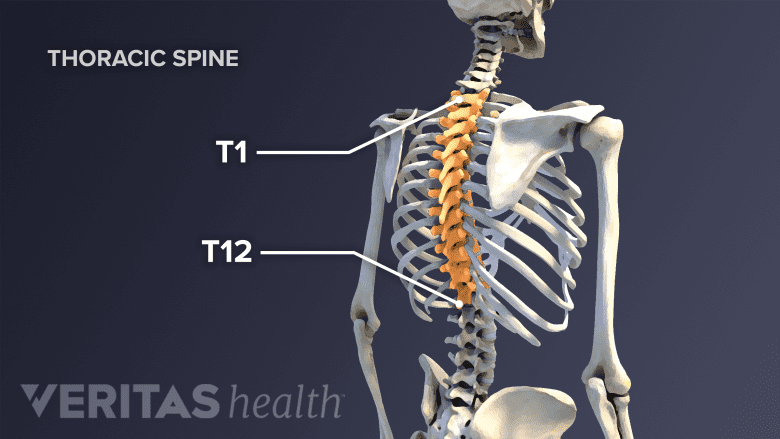The thoracic spine—also referred to as the upper back or middle back—is designed for stability to anchor the rib cage and protect vital internal organs within the chest.
Compared to the neck (cervical spine) and lower back (lumbar spine), the upper back is remarkably resistant to injury and pain. When upper back pain does occur, it is typically due to long-term poor posture or an injury that overpowers the thoracic spine’s sturdiness.
Watch Spine Anatomy Overview Video
This article explores various symptoms of upper back pain, potential causes, and modern diagnostic methods and treatments.
In This Article:
The Thoracic Spine and What Can Go Wrong

The thoracic spine's limited mobility is due to its connection with the rib cage.
The thoracic spine starts beneath the neck and is comprised of 12 vertebrae, labeled T1 through T12, which go down the back of the torso (Figure 1). Unlike the cervical spine and lumbar spine, the thoracic spine is relatively immobile because each of its vertebrae are connected to a pair of ribs (one on each side), which along with the sternum at the front of the chest combine to form the rib cage.
See Thoracic Vertebrae and the Rib Cage
If the upper back becomes painful, it is typically for one of the following two reasons:
- Muscular irritation. The shoulder girdle attaches by large muscles to the scapula (the shoulder blade) and the back of the rib cage. These large upper back muscles are prone to developing strains or tightness that can be painful and difficult to alleviate. Muscular irritation in the upper back is typically due to either de-conditioning (lack of strength) or overuse injuries (such as repetitive motions).
- Joint dysfunction. Either from a sudden injury or natural degeneration due to aging, joints in the thoracic spine can become dysfunctional and painful. Some examples could include a facet joint’s cartilage or joint capsule tearing
If upper back pain becomes bad enough to limit activities, it usually feels like a sharp, burning pain localized to one spot or a general achiness that can flare up and possibly spread to the shoulder, neck, or elsewhere.
The Course of Upper Back Pain

Upper back pain often arises from poor posture while working.
Few studies have been done to track the frequency of upper back pain. A French study of workers across various professions found about 9% of men and 17% of women reported at least some upper back pain, but other studies have found numbers that range lower and higher.1Fouquet N, Bodin J, Descatha A, et al. Prevalence of thoracic spine pain in a surveillance network. Occup Med (Lond). 2015;65(2):122-5.,2Briggs AM, Smith AJ, Straker LM, Bragge P. Thoracic spine pain in the general population: prevalence, incidence and associated factors in children, adolescents and adults. A systematic review. BMC Musculoskelet Disord. 2009;10:77.
Upper back pain can appear suddenly, such as from an injury or for no apparent reason. It can also start gradually, such as from sitting with poor posture at work.
In some cases, upper back pain can be managed with self-care, including rest, adjusting posture, or applying heat or ice. If the pain persists, other treatments may be needed, such as medication, physical therapy, or manual manipulation.
Due to a combination of the thoracic spine’s rigidity and close proximity to the heart, lungs, and other vital organs, surgery is less likely to be performed on the thoracic spine compared to the cervical and lumbar spines. Only in rare cases will an MRI or CT scan find an anatomic problem in the thoracic spine that is amenable to any sort of surgical solution for upper back pain.
When Upper Back Pain Is Serious
Most cases of upper back pain are not due to a serious underlying cause, but rare cases may be caused by a progressing infection or illness, or from spinal instability that has started to affect a nerve root or even the spinal cord. In such cases, it is important to seek medical treatment immediately to reduce the risk of the problem becoming worse.
Symptoms that could indicate a serious underlying cause of upper back pain include radiating pain or pins-and-needles tingling in the chest or abdomen, fever or chills, reduced coordination, problems walking, or severe headache. In addition, upper back pain that follows a high-impact event, such as an auto accident or fall from a ladder, should be evaluated by a doctor.
- 1 Fouquet N, Bodin J, Descatha A, et al. Prevalence of thoracic spine pain in a surveillance network. Occup Med (Lond). 2015;65(2):122-5.
- 2 Briggs AM, Smith AJ, Straker LM, Bragge P. Thoracic spine pain in the general population: prevalence, incidence and associated factors in children, adolescents and adults. A systematic review. BMC Musculoskelet Disord. 2009;10:77.

